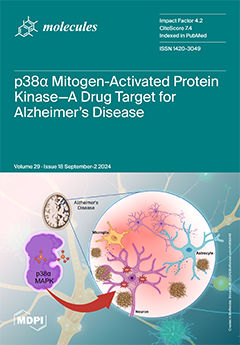2-Chloropyridine-3-carbonitrile derivative
1 was utilized as a key precursor to build a series of linear and angular annulated pyridines linked to a 6-hydroxy-4,7-dimethoxybenzofuran moiety. Reaction of substrate
1 with various hydrazines afforded pyrazolo[3,4-
b]pyridines. Treatment of substrate
1 with 1,3-
N,
[...] Read more.
2-Chloropyridine-3-carbonitrile derivative
1 was utilized as a key precursor to build a series of linear and angular annulated pyridines linked to a 6-hydroxy-4,7-dimethoxybenzofuran moiety. Reaction of substrate
1 with various hydrazines afforded pyrazolo[3,4-
b]pyridines. Treatment of substrate
1 with 1,3-
N,
N-binucleophiles including 3-amino-1,2,4-triazole, 5-amino-1
H-tetrazole, 3-amino-6-methyl-1,2,4-triazin-5(4
H)-one and 2-aminobenzimidazole produced the novel angular pyrido[3,2-
e][1,2,4]triazolo[4,3-
a]pyrimidine, pyrido[3,2-
e][1,2,4]tetrazolo[1,5-
a]pyrimidine, pyrido[3′,2′:5,6] pyrimido[2,1-
c][1,2,4]triazine and benzo[4,5]imidazo[1,2-
a]pyrido[3,2-
e]pyrimidine, respectively. Reaction of substrate
1 with 1,3-
C,
N-binucleophiles including cyanoacetamides and 1
H-benzimidazol-2-ylacetonitrile furnished 1,8-naphthyridines and benzoimidazonaphthyridine. Moreover, reacting substrate
1 with 5-aminopyrazoles gave pyrazolo[3,4-
b][1,8]naphthyridines. Finally, reaction of compound
1 with 6-aminouracils as cyclic enamines yielded pyrimido[4,5-
b][1,8]naphthyridines. Some of the synthesized products showed noteworthy antimicrobial efficiency against all types of microbial strains. Structures of the produced compounds were established using analytical and spectroscopic tools.
Full article






